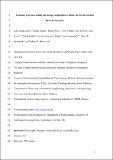Files in this item
Estuarine processes modify the isotope composition of dissolved riverine barium fluxes to the ocean
Item metadata
| dc.contributor.author | Bridgestock, Luke | |
| dc.contributor.author | Nathan, Joseph | |
| dc.contributor.author | Paver, Robert | |
| dc.contributor.author | Hsieh, Yu-Te | |
| dc.contributor.author | Porcelli, Don | |
| dc.contributor.author | Tanzil, Jani | |
| dc.contributor.author | Holdship, Phil | |
| dc.contributor.author | Carrasco, Gonzalo | |
| dc.contributor.author | Annammala, Kogila Vani | |
| dc.contributor.author | Swarzenski, Peter W. | |
| dc.contributor.author | Henderson, Gideon M. | |
| dc.date.accessioned | 2023-03-20T12:30:13Z | |
| dc.date.available | 2023-03-20T12:30:13Z | |
| dc.date.issued | 2021-09-30 | |
| dc.identifier | 283736625 | |
| dc.identifier | efea2d1f-3930-40da-b5ca-605e3d79535e | |
| dc.identifier | 85107411320 | |
| dc.identifier.citation | Bridgestock , L , Nathan , J , Paver , R , Hsieh , Y-T , Porcelli , D , Tanzil , J , Holdship , P , Carrasco , G , Annammala , K V , Swarzenski , P W & Henderson , G M 2021 , ' Estuarine processes modify the isotope composition of dissolved riverine barium fluxes to the ocean ' , Chemical Geology , vol. 579 , 120340 . https://doi.org/10.1016/j.chemgeo.2021.120340 | en |
| dc.identifier.issn | 0009-2541 | |
| dc.identifier.other | ORCID: /0000-0001-7636-6090/work/131122783 | |
| dc.identifier.uri | https://hdl.handle.net/10023/27226 | |
| dc.description | Funding: Luke Bridgestock was supported by a Leverhulme Trust Early Career Fellowship (ECF-2019-049) for part of this research. The collection of Johor River estuary samples was supported by funding from the Singapore National Research Foundation (NRF), Prime Minister's Office, under the Marine Science Research and Development Programme (Project MSRDP-03) and the Royal Society's Commonwealth Science Grant (CSC\R1\170048). The IAEA is grateful for the support provided to its Environment Laboratories by the Government of the Principality of Monaco. | en |
| dc.description.abstract | Barium (Ba) isotope variations offer the potential to trace environmental processes, including long-term changes in river discharge and marine export production. Riverine inputs are an important source of dissolved Ba to the ocean, which we estimate to be ~10 to 20 Gmol yr−1. A large fraction (~20 to 75%) of this net riverine dissolved Ba flux to the ocean is derived from estuarine processes, in particular the release of exchangeable Ba from riverine suspended particles due to exchange with major cations in seawater. Despite the importance of this process for controlling the input of dissolved Ba to the ocean, its impact on the δ138/134Ba of net riverine dissolved Ba fluxes remains unknown. To address this observational gap, Ba concentration and isotope data from across the estuarine mixing zones of the Amazon (Brazil), Fly (Papua New Guinea) and Johor (Malaysia) Rivers are presented. Desorption from suspended riverine particles releases Ba with δ138/134Ba 0.2 to 0.3‰ lower than corresponding river dissolved loads, modifying the isotope composition of net riverine dissolved Ba fluxes that reach the ocean. This offset likely represents an isotope fractionation accompanying the adsorption of Ba by particulate phases within river catchments, which can explain the systematic enrichment of heavier Ba isotopes in river dissolved loads relative to weathering lithologies. River dissolved loads are also systematically offset to higher δ138/134Ba than the main oceanic Ba sink: burial of BaSO4 in marine sediment. This represents an apparent imbalance in the modern marine Ba isotope budget. Our results suggest that accounting for modification of the δ138/134Ba of net riverine Ba fluxes to the ocean by estuarine processes is likely to play a key role towards balancing the modern marine Ba isotope budget. | |
| dc.format.extent | 13 | |
| dc.format.extent | 3076006 | |
| dc.language.iso | eng | |
| dc.relation.ispartof | Chemical Geology | en |
| dc.subject | Ba isotopes | en |
| dc.subject | Estuaries | en |
| dc.subject | Riverine Ba fluxes | en |
| dc.subject | QE Geology | en |
| dc.subject | DAS | en |
| dc.subject | SDG 14 - Life Below Water | en |
| dc.subject | MCC | en |
| dc.subject.lcc | QE | en |
| dc.title | Estuarine processes modify the isotope composition of dissolved riverine barium fluxes to the ocean | en |
| dc.type | Journal article | en |
| dc.contributor.institution | University of St Andrews. School of Earth & Environmental Sciences | en |
| dc.identifier.doi | https://doi.org/10.1016/j.chemgeo.2021.120340 | |
| dc.description.status | Peer reviewed | en |
| dc.date.embargoedUntil | 2022-06-01 | |
| dc.identifier.url | https://www.repository.cam.ac.uk/handle/1810/324020 | en |
This item appears in the following Collection(s)
Items in the St Andrews Research Repository are protected by copyright, with all rights reserved, unless otherwise indicated.

